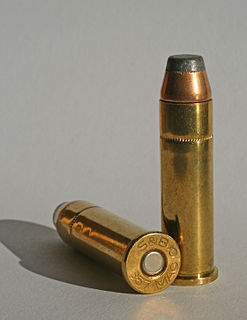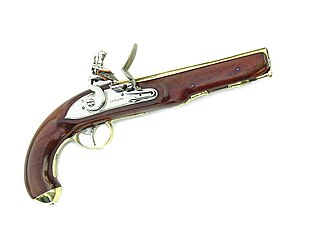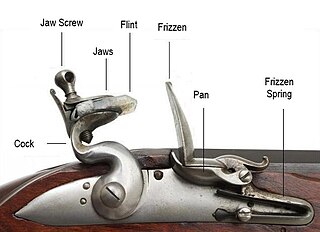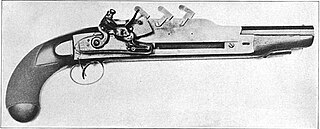
A firearm is a type of gun designed to be readily carried and used by a single individual. The term is legally defined further in different countries.

The percussion cap or percussion primer, introduced in the early 1820s, is a type of single-use percussion ignition device for muzzleloader firearm locks enabling them to fire reliably in any weather condition. This crucial invention gave rise to the caplock mechanism or percussion lock system using percussion caps struck by the hammer to set off the gunpowder charge in percussion guns including percussion rifles and cap and ball firearms. Any firearm using a caplock mechanism is a percussion gun. Any long gun with a caplock mechanism and rifled barrel is a percussion rifle. Cap and ball describes caplock firearms discharging a single bore-diameter spherical bullet with each shot.
Tubes and primers are used to ignite the propellant in projectile weapons.

A muzzleloader is any firearm into which the projectile and usually the propellant charge is loaded from the muzzle of the gun. This is distinct from the more popular modern designs of breech-loading firearms. The term "muzzleloader" applies to both rifled and smoothbore type muzzleloaders, and may also refer to the marksman who specializes in the shooting of such firearms. The firing methods, paraphernalia and mechanism further divide both categories as do caliber.

Flintlock is a general term for any firearm that uses a flint striking ignition mechanism. The term may also apply to a particular form of the mechanism itself, also known as the true flintlock, that was introduced in the early 17th century, and rapidly replaced earlier firearm-ignition technologies, such as the matchlock, the wheellock, and the earlier flintlock mechanisms.

A wheellock, wheel-lock or wheel lock, is a friction-wheel mechanism to cause a spark for firing a firearm. It was the next major development in firearms technology after the matchlock and the first self-igniting firearm. Its name is from its rotating steel wheel to provide ignition. Developed in Europe around 1500, it was used alongside the matchlock and was later superseded by the snaplock (1540s), the snaphance (1560s) and the flintlock.

The matchlock was the first mechanism invented to facilitate the firing of a hand-held firearm. Before this, firearms had to be fired by applying a lit match to the priming powder in the flash pan by hand; this had to be done carefully, taking most of the soldier's concentration at the moment of firing, or in some cases required a second soldier to fire the weapon while the first held the weapon steady. Adding a matchlock made the firing action simple and reliable by a single soldier, allowing them to keep both hands steadying the gun and eyes on the target while firing.

A snaphance or snaphaunce is a type of lock for firing a gun or is a gun using that mechanism. The name is Dutch in origin but the mechanism cannot be attributed to the Netherlands with certainty. It is the mechanical progression of the wheellock firing mechanism, and along with the miquelet lock and doglock are predecessors of the flintlock mechanism. It fires from a flint struck against a striker plate above a steel pan to ignite the priming powder which fires the gun. Examples of this firearm can be found through Europe, North Africa, and the Middle East.

A centerfire cartridge is a cartridge with a primer located in the center of the cartridge case head. Unlike rimfire cartridges, the primer is a separate and replaceable component. Centerfire cartridges have supplanted the rimfire variety in all but the smallest cartridge sizes. With the exception of a few .17 caliber, .20 caliber, and .22 caliber pistol and rifle cartridges, small-bore shotgun cartridges, and a handful of antique, mostly obsolete cartridges, almost all pistol, rifle, and shotgun ammunition used today is centerfire.

The flintlock mechanism is a type of lock used on muskets, rifles, and pistols from the early 17th to the mid-19th century. It is commonly referred to as a "flintlock", though that term is also commonly used for the weapons themselves as a whole, and not just the lock mechanism.

Slow match, also called match cord, is the slow-burning cord or twine fuse used by early gunpowder musketeers, artillerymen, and soldiers to ignite matchlock muskets, cannons, shells, and petards. Slow matches were most suitable for use around black-powder weapons because a slow match could be roughly handled without going out, and only presented a small glowing tip instead of a large flame that risked igniting nearby gunpowder. Slow match of various types was one of the first kinds of artillery fuse.

A snaplock is a type of lock for firing a gun or is a gun fired by such a lock.

A touch hole, also called a vent, is a small hole near the rear portion (breech) of a cannon or muzzleloading gun—that is, the part where the combustion of the powder charge occurs, at the end opposite from the muzzle from which the projectile is fired from the barrel. The vent is the access point through which the propellant charge is ignited. In small arms, the flash from a charge of priming held in the flash pan is enough to ignite the charge within. In artillery, priming powder, a fuse, squib, or friction igniter is inserted into the touch hole to ensure ignition of the charge.

The snap matchlock is a type of matchlock mechanism used to ignite early firearms. It was used in Europe from about 1475 to 1640, and in Japan from 1543 until about 1880.

Naval artillery in the Age of Sail encompasses the period of roughly 1571–1862: when large, sail-powered wooden naval warships dominated the high seas, mounting a bewildering variety of different types and sizes of cannon as their main armament. By modern standards, these cannon were extremely inefficient, difficult to load, and short ranged. These characteristics, along with the handling and seamanship of the ships that mounted them, defined the environment in which the naval tactics in the Age of Sail developed.

The frizzen, historically called the "hammer" or the steel, is an "L"-shaped piece of steel hinged at the front used in flintlock firearms. The frizzen is held in one of two positions, opened or closed, by a leaf spring. When closed, it is positioned over the flash pan so as to enclose a small priming charge of black powder next to the flash hole that is drilled through the barrel into which the main charge has been loaded. When the trigger is pulled, the hammer or cock which includes a shaped piece of flint held in a set of jaws with a scrap of leather or thin piece of lead, snaps forward causing the flint to scrape downward along the frizzen's face, throwing it forward into the open position and exposing the priming powder. The flint scraping along the steel causes a shower of sparks to be thrown into the pan, thereby igniting the priming powder therein and sending flames through the touch hole, which in turn ignites the main charge of black powder in the breech of the barrel, driving the projectile out of the muzzle.

A handgun is a short-barrelled firearm that can be held and used with one hand. The two most common handgun sub-types in use today are revolvers and semi-automatic pistols, although other handguns like machine pistols and derringers also see infrequent usage.

In firearms, the cylinder is the cylindrical, rotating part of a revolver containing multiple chambers, each of which is capable of holding a single cartridge. The cylinder revolves around a central axis in the revolver to sequentially bring each individual chamber into alignment with the barrel for repeated firing. Each time the gun is cocked, the cylinder indexes by one chamber. Like a magazine, the cylinder stores ammunitions within the revolver and allows the gun to fire multiple times before needing to reload.

A superposed load or stacked charge or superimposed load is a method used by various muzzleloading firearms, from matchlocks to caplocks, as well as newer Metal Storm weapons, to fire multiple shots from a single barrel without reloading. In a sense, superposed load guns were the first automatic firearms, as they fired multiple shots per pull of the trigger.
In firearms and artillery, the primer is the chemical and/or device responsible for initiating the propellant combustion that will push the projectiles out of the gun barrel.


















